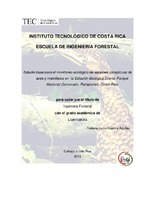Mostrar el registro sencillo del ítem
Estudio base para el monitoreo ecológico de especies conspicuas de aves y mamíferos en la Estación Biológica Sirena, Parque Nacional Corcovado, Puntarenas, Costa Rica
| dc.contributor.author | Loayza-Aguilar, Tatiana Lucía | |
| dc.date.accessioned | 2017-05-25T20:25:27Z | |
| dc.date.available | 2017-05-25T20:25:27Z | |
| dc.date.issued | 2013 | |
| dc.identifier.uri | https://hdl.handle.net/2238/7107 | |
| dc.description | Proyecto de Graduación (Licenciatura en Ingeniería Forestal) Instituto Tecnológico de Costa Rica, Escuela de Ingeniería Forestal, 2013. | es |
| dc.description.abstract | A study based on an ecological monitoring conspicuous species of birds and mammals at the Sirena Biological Station, Corcovado National Park. Two types of coverage were selected: primary forest (BP) and secondary forest (BS) for each type, there were 9 nine days of work and two periods of the day (morning and afternoon). Wildlife sampling was executed simultaneously using two methods: path traces and point count sightings with infinite radius. There were 8 species of mammals and 3 species of birds found. The puma and white-lipped peccary were observed outside the sampling period. An inventory of tree species for each type of coverage also took place, using circular plot radius 5 m. 20 species were recorded for BP and 14 species for BS. The technique of linear and mixed models indicated that for the variables "number of individuals", "distance" and "height" there were found no significant differences in the interactions coverage * day period and in each of these main effects. By multivariate analysis techniques based on principal coordinates (CP), conglomerates and discriminant analysis identified four groups of species of wildlife. Outstanding variable for group 1 (red brocked deer (Mazama americana), agouti (Dasyprocta punctata), squirrel (Sciurus granatensis), great tinamou (Tinamus major), great curassow (Crax rubra) and bare throated tiger heron (Tigrisoma Mexicana)) was "transit", for group 2 (collared peccary (Pecari tajacu) and tapir (Tapirus bairdii)) "fingerprint", for group 3 (coati (Nasua narica) and northern tamandua (Tamandua Mexicana)) "type of coverage" and for group 4 (primates) "number of individuals", "distance" and "height". This study could serve as a simple guide for the implementation of ecological monitoring in Sirena Biological Station, integrating volunteers of Protected Areas (ASP), as well as professionals in the field of biological sciences. | es |
| dc.description.sponsorship | Estación Biológica Sirena, Parque Nacional Corcovado, Puntarenas, Costa Rica | es |
| dc.language.iso | spa | es |
| dc.publisher | Instituto Tecnológico de Costa Rica | es |
| dc.subject | Aves | es |
| dc.subject | Regiones tropicales | es |
| dc.subject | Monitoreo | es |
| dc.subject | Fauna | es |
| dc.subject | Áreas silvestres | es |
| dc.subject | Research Subject Categories::FORESTRY, AGRICULTURAL SCIENCES and LANDSCAPE PLANNING::Plant production::Forestry | es |
| dc.title | Estudio base para el monitoreo ecológico de especies conspicuas de aves y mamíferos en la Estación Biológica Sirena, Parque Nacional Corcovado, Puntarenas, Costa Rica | es |
| dc.type | licentiateThesis | es |


